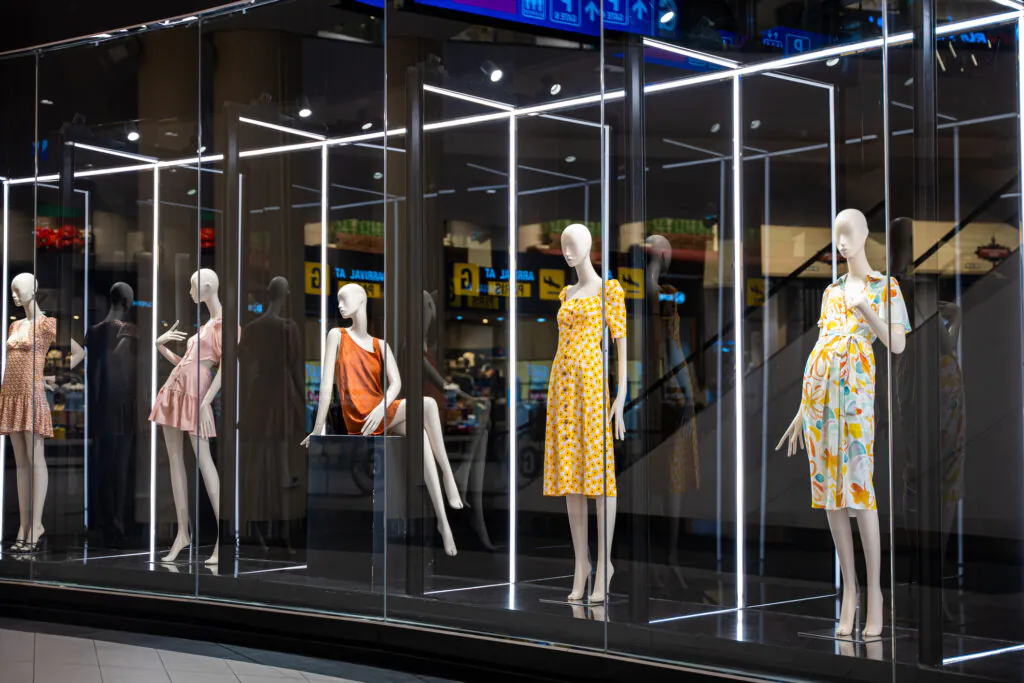Introduction to Visual Merchandising
Visual merchandising is presenting, arranging, and displaying products in a way that makes them grab the shopper’s eye and encourages them to pick up, try on, and ultimately buy the merchandise. The visual merchandising strategy is a widely adopted practice in the retail industry to enhance customer appeal; merchandisers develop floor plans and three-dimensional product displays to organize and showcase products to maximize in-store sales. In larger companies, merchandisers work hand-in-hand with the retail marketing teams to build product displays that fit with the brand’s image and guidelines. Independent retailers, on the other hand, have more control over what the displays look like and, therefore, more room for creativity.
Importance of Visual Merchandising in Retail
In the retail industry, visual merchandising is all about the visual experience that you give to your customers through the overall store setup, which prompts them to walk into your store and make a purchase. Understanding your customers, especially in terms of customer psychographics and looking at things from a customer’s perspective, is one of the critical ingredients for success in the retail business. Visual merchandising also includes gathering ideas on what exactly your target audience is looking for and evaluating the same against the existing facilities at your store. This will help you know the gaps and bridge them more effectively.
Visual merchandising is crucial in the retail industry for several reasons:
Captures Attention
Eye-catching displays and strategic product placements draw customers into the store, making them curious about the products.
Enhances Customer Experience
Well-designed layouts create a pleasant shopping environment, encouraging customers to spend more time in the store.
Boosts Sales
By highlighting key products and promotions, visual merchandising can drive impulse purchases and increase overall sales.
Builds Brand Identity
Consistent themes, colors, and styles in visual merchandising help establish a strong brand identity, making the store more recognizable and memorable to customers.
Influences Buying Decisions
Strategic placement of products can guide customers through the store and subtly influence their purchasing decisions, often leading to higher sales of targeted items.
Promotes New Products
Visual merchandising is an incredibly effective way to highlight new arrivals and seasonal items, ensuring they get the attention they truly deserve.
The Five Key Elements of Visual Merchandising

Whie there are various components that come into play when crafting visual merchandising displays, but the elements mentioned below are the most important ones:
Focal Point
It is that part of the display that you want people to focus on. Placing the focal point at eye level helps draw attention and makes it easier for customers to notice. The focal point could be an item (or a group of products) you want shoppers to notice.
Space
The amount of space between products can convey volumes. In retail, customers often equate space with luxury, which is why high-end brands put a lot of space between merchandise when displaying them in-store. Conversely, discount retailers tend to fill up their shelves with more products, leaving less space between items.
Colors
Different colors invoke emotions, memories, and even specific reactions and behaviors in consumers and influence purchasing decisions. Red, for example, is often used in “SALE” signs as it conveys energy and urgency. Black, on the other hand, can represent luxury, so it is commonly seen in high-end boutiques.
Lighting
Proper and strategically placed lighting can help draw customers’ attention to specific parts of your store or display. If you want to highlight certain items more than others, then placing them under brighter lighting is a good idea. In some cases, lighting can also influence people’s moods and behaviors.
Positioning
Positioning is another key factor in merchandising. Consumers tend to browse shelves at eye-level. They will also focus more on things right in front of them, rather than look at the sides or at the back of a display. Therefore, high-demand items should be placed at eye level; complementary products can be positioned nearby to encourage additional purchases.
Key Tips for Effective Visual Merchandising
How to boost your retail performance with proven visual merchandising tips designed to attract customers and drive sales:
| Tip | How it makes a difference |
| Change your displays on a monthly basis | Regularly updating your displays keeps the store looking fresh and engaging. It also allows you to highlight new products and seasonal items, keeping customers interested and encouraging repeat visits. |
| Visualize the products that customers want, not need | Focus on aspirational items that customers desire. These products often have a higher emotional appeal and can drive impulse purchases. Showcase them in a way that highlights their benefits and unique features. |
| Look for grouping features other than price | Group products by themes, colors, or usage rather than just price. This can create a more cohesive and visually appealing display, making it easier for customers to find related items and encouraging them to buy more. |
| Focus on the front part of your store | The front area of your store is the first thing customers see, so make it inviting and attractive. Use this space to showcase your best-selling or most appealing products to draw customers in. |
| Add additional lighting to make the merchandise stand out | Good lighting can make a significant difference in how products are perceived. Use spotlights or accent lighting to highlight key items and create a warm, inviting atmosphere. |
| Add eye-catching signage | Use bold, clear signage to draw attention to promotions, new arrivals, or special features. The signage should be easy to read and strategically placed to guide customers through the store. |
| Rotate displays but not your fixtures | Regularly changing the products in your displays keeps the store looking fresh without the need for a complete overhaul. This approach saves time and resources while still providing a new look for customers. |
| Ensure that everything in the display is priced | Clearly pricing all items in your displays helps customers make quick purchasing decisions and reduces the need for them to ask for assistance, enhancing their shopping experience. |
| Add motion to your displays | Incorporate elements like digital screens, rotating stands, or interactive features to catch customers’ attention. Movement naturally draws the eye and can make your displays more engaging. |
| Focus on more than one sense in your store | Engage multiple senses to create a memorable shopping experience. Use pleasant scents, background music, and tactile elements to complement your visual displays and create a more immersive environment. |
Case Study: Successful Visual Merchandising Strategies
| Case Study: How a Footwear Brand used Visual Merchandising to Boost Its Sales |
| Background: Zara, a leading global fashion retailer, is well known for its fast fashion and trendy designs. To maintain its competitive edge, Zara places a strong emphasis on visual merchandising to attract customers and enhance their shopping experience. |
| Objectives of the Strategy: Create an engaging and dynamic in-store environment. Highlight new collections and seasonal trends. Encourage impulse purchases through strategic product placement. |
| Strategies Used: Frequent Updates: Zara changes its store displays frequently, often on a weekly basis, to keep the shopping experience fresh and exciting. This approach ensures that customers always find something new and are encouraged to visit the store regularly. Thematic Displays: Zara uses thematic displays to highlight new collections and seasonal trends. These displays are designed to tell a story, making it easier for customers to visualize how the pieces can be worn together. Strategic Product Placement: Key items and bestsellers are placed at eye level and in high-traffic areas to maximize visibility. Zara also uses mannequins extensively to display complete outfits, helping customers see how different pieces can be styled. Minimalist Design: Zara’s stores feature a minimalist design with clean lines and neutral colors. This design approach ensures that the focus remains on the products, making them stand out more. Effective Lighting: Zara uses a combination of ambient and accent lighting to highlight key products and create a warm, inviting atmosphere. Proper lighting enhances the visual appeal of the merchandise and makes the store more attractive. Results: Increased Foot Traffic: The frequent updates and engaging displays attract more customers to the store, leading to higher foot traffic. Higher Sales: The strategic placement of products and thematic displays drive impulse purchases, contributing to increased sales. Enhanced Brand Image: Zara’s consistent and stylish visual merchandising reinforces its brand image as a trendy and fashionable retailer. This case study illustrates how effective visual merchandising can significantly impact a retailer’s success by attracting customers, driving sales, and reinforcing brand identity. |
Future Trends in Visual Merchandising
Visual merchandising is evolving rapidly, with new and exciting trends to catch on in the future:
Interactive Displays
These engage customers by allowing them to interact with products in unique ways, such as touch screens or virtual reality experiences.
Sustainability
With growing environmental consciousness, businesses are incorporating eco-friendly materials and highlighting sustainable practices in their displays.
Minimalism
Clean, clutter-free displays that let products take center stage are becoming increasingly popular.
Storytelling
Creating displays that tell a story can connect with customers on an emotional level, making their shopping experience more memorable.
Personalization
Using technology to gather data about customer preferences allows for tailored displays and product recommendations.
Conclusion
Visual merchandising is a powerful tool in the retail industry, transforming ordinary retail spaces into captivating environments that attract and engage customers. By strategically using elements like color, lighting, and layout, retailers can create immersive experiences that not only highlight products but also tell a brand’s story. Effective visual merchandising not only enhances the shopping experience but also drives sales and builds brand loyalty. In today’s competitive retail landscape, mastering the art of visual merchandising is essential for any retailer aiming to stand out and succeed in the extremely competitive retail environment.
To know more about the importance of visual merchandising in the retail industry – Request more info.


